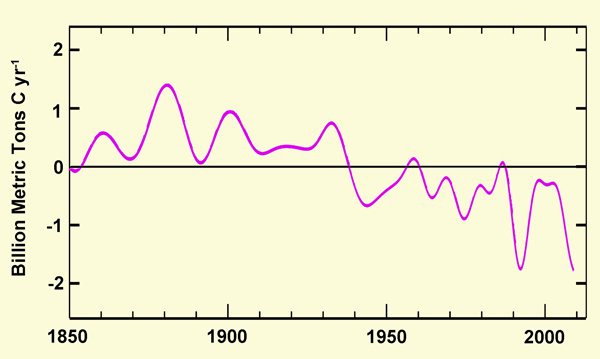Volume 13, Number 30: 28 July 2010
Periodically, even in some of the world's most prestigious scientific journals, we read that the natural sinks of earth's carbon cycle are becoming ever less effective in removing from the atmosphere the CO2 that we routinely release to it as a result of our energy-intensive activities (Canadell et al., 2007; LeQuere et al., 2007). Now, however, that scientific myth appears to have been put to rest by a new analysis of real-world data.
In a study published in the December 2009 issue of Oceanography that considered a number of related topics, NOAA's Pieter Tans employed measurements of atmospheric and oceanic carbon contents, along with reasonably constrained estimates of global anthropogenic CO2 emissions, to calculate the residual fluxes of carbon (in the form of CO2) from the terrestrial biosphere to the atmosphere (+) or from the atmosphere to the terrestrial biosphere (-), obtaining the results depicted in the figure below.

Figure 1. Five-year smoothed rates of carbon transfer from land to air (+) or from air to land (-) vs. time. Adapted from Tans (2009).
As can be seen from this figure, earth's land surfaces were a net source of CO2-carbon to the atmosphere until about 1940, primarily due to the felling of forests and the plowing of grasslands to make way for expanded agricultural activities. From 1940 onward, however, the terrestrial biosphere has become, in the mean, an increasingly greater sink for CO2-carbon; and it has done so even in the face of massive global deforestation, for which it has more than compensated.
In light of these findings, and the fact that they do "not depend on models" but "only on the observed atmospheric increase and estimates of fossil fuel emissions," Tans concluded that "suggestions that the carbon cycle is becoming less effective in removing CO2 from the atmosphere (e.g., LeQuere et al., 2007; Canadell et al., 2007) can perhaps be true locally, but they do not apply globally, not over the 50-year atmospheric record, and not in recent years." In fact, he goes on to say that "to the contrary" and "despite global fossil fuel emissions increasing from 6.57 GtC in 1999 to 8.23 in 2006, the five-year smoothed global atmospheric growth rate has not increased during that time, which requires more effective uptake [of CO2] either by the ocean or by the terrestrial biosphere, or both, to satisfy atmospheric observations." And the results portrayed in the figure we have adapted from Tans' paper clearly indicate that this "more effective uptake" of CO2-carbon has occurred primarily over land.
This observation-based analysis of real-world data pretty much verifies both the reality and the tremendous strength of the CO2-induced Greening of the Earth phenomenon, which has been observed in numerous independent studies conducted throughout the world, the reviews of many of which we have archived in our Subject Index. In addition, it refutes the unfounded arguments of climate alarmists, who contend that various environmental stresses and resource limitations will not allow the full potential of the well-documented aerial fertilization effect of atmospheric CO2 enrichment to be manifest in nature. Indeed, this phenomenon is itself a "force of nature" that can be neither hindered nor halted, as it bestows its blessings upon wild and domesticated plants alike, without regard for artificial boundaries drawn on maps or the political persuasions of man.
Sherwood, Keith and Craig Idso
References
Canadell, J.G., LeQuere, C., Raupach, M.R., Field, C.B., Buitenhuis, E.T,., Ciais, P., Conway, T.J., Gillett, N.P., Houghton, R.A. and Marland, G. 2007. Contributions to accelerating atmospheric CO2 growth from economic activity, carbon intensity, and efficiency of natural sinks. Proceedings of the National Academy of Sciences of the United States of America 104: 18,866-18.870.
LeQuere, C., Rodenbeck, C., Buitenhuis, E.T., Conway, T.J., Langenfelds, R., Gomez, A., Labuschagne, C., Ramonet, M., Nakazawa, T., Metzl, N., Gillett, N. and Heimann, M.. 2007. Saturation of the Southern Ocean CO2 sink due to recent climate change. Science 316: 1735-1738.
Tans, P. 2009. An accounting of the observed increase in oceanic and atmospheric CO2 and an outlook for the future. Oceanography 22: 26-35.




